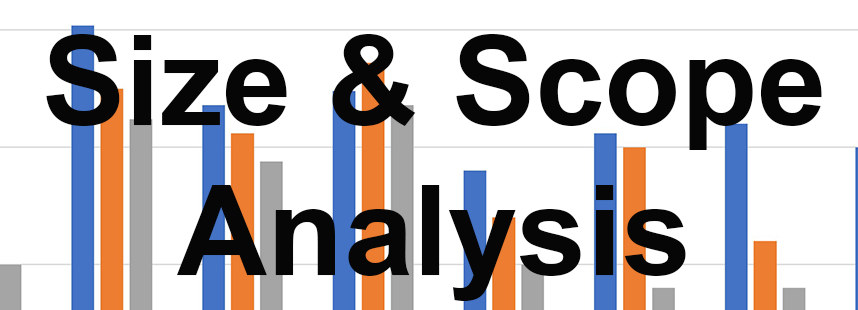by Brian de Lore
Published 11th January 2025
The four graphs depicted below result from industry-published Size & Scope Reports, extracted from a 21-year window on the https://www.tabnz.org/reports and https://nztr.co.nz/publications websites, beginning with season 2002-03, progressing to 2016-17, and concluding with season 2022-23.
The figures in the graphs are taken only from the three documents, except for three or four numbers that could only be supplied by the NZ Stud Book or accurately calculated.
Examining this history, knowing the facts and the direction in which this business is trending is the only way of predicting where the thoroughbred industry is going. But too many people involved in this business are apathetic or disinterested in such matters.
The reference is to those ‘living in the now’ with no thought about what needs to be fixed and how to do it. Racing’s Zombies exist in large numbers, ignorant of the past and thoughtless of the future, holding the view that everything will remain constant from one week to the next.
Racing Minister Winston Peters referred to the Zombies when, in August 2017, he said: “…the racing industry should take a long, hard look at itself in the mirror and then get its act together before its fortunes can be turned around.”
Zombies don’t own mirrors; they didn’t look and did nothing until Winston relented and came to the rescue in May 2020. He grabbed the TAB by the scruff of the neck and saved it from the cliff edge with a $50 million bailout – $35 million of which was unpaid debt.
Then, Entain followed three years later with a ‘hundreds of millions’ of dollars partnership (saving the TAB again) package – five years after John Messara AM implored the Zombies to partner/outsource the TAB immediately.
Thank you, Entain, for reinvigorating racing with increased stakes, which owners are currently enjoying one-and-a-half years into the five-year duration of guarantees. However, the stakes of the honeymoon period have overshadowed the predicament of the breeding industry, which is in a serious state of malaise.
Take a close look at this breeding graph:
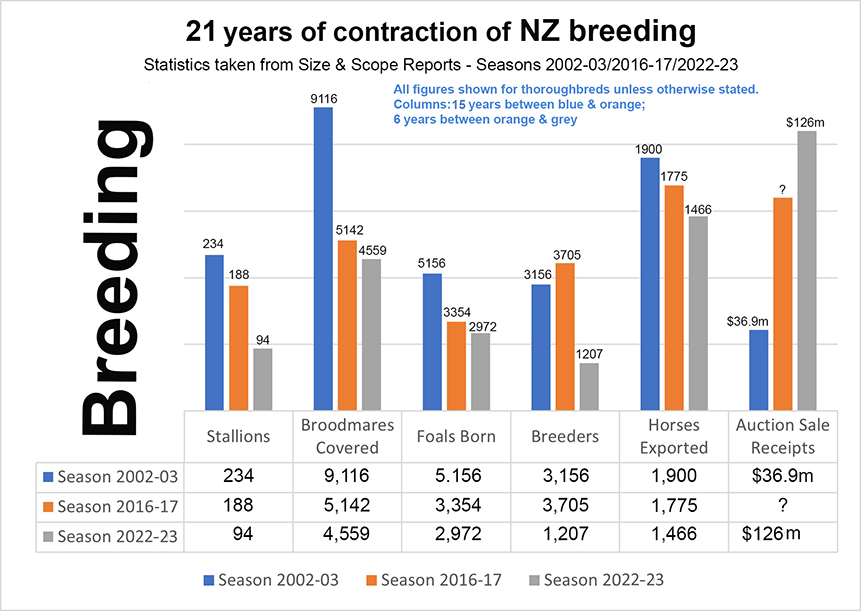
The decline in the number of thoroughbreds bred is nothing short of alarming. As already stated, these figures come from the Size & Scope Report completed in January 2024 (for the season ending 2022-23). This week, the Stud Book provided an up-to-date number of live foals in 2022-23, downsizing the number from 2972 to 2805 after natural attrition (dead foals).
More alarming, the broodmares covered figure of 4559 in 2022-23 (halved in 21 years) has dropped significantly again in the 2023-34 season to 4165 – a decrease of almost 400 coverings in one season. If we apply the same ratio of coverings to foals to project the final foaling number in 2024, it will be in the vicinity of 2561.
The number of breeders dropped to 38.2 percent of the original from year one in 21 years – 3156 to 1207. It rose in the first 15 years to 3705 through syndication or shared ownership but took a significant hit in the ensuing six years. With 394 fewer mares covered in 2023, the number of breeders will decline again in accordance with the decrease in coverings.
Here’s the racing graph:
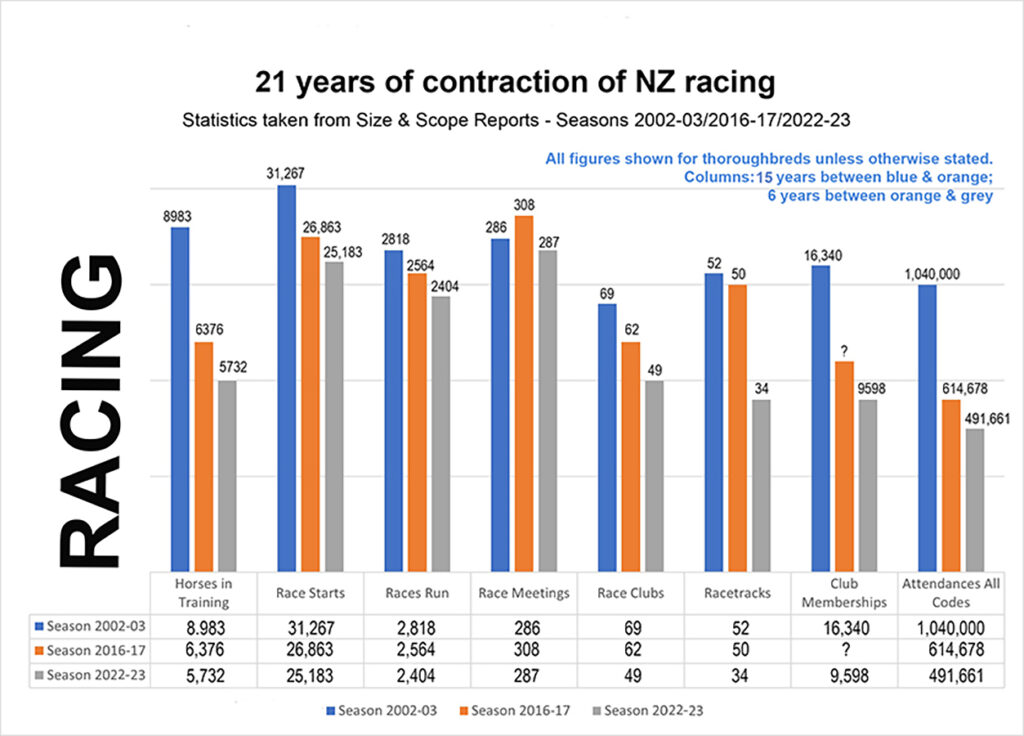
The attrition for racing is not as pronounced as the breeding industry, but the figures say that in 21 years, 36.2 percent fewer horses were in training at the end of 2022-23.
The most significant decline came in club memberships (-41.3%) and racecourse attendance for all three codes (-52.7%).
Race clubs went by the board by an average of one a year for 21 years (-29%), but 15 occurred in the final six years. All but two losses of 18 racecourses happened in the final six of the 21 seasons.
NZTR minimised the diminishing number of race meetings but only at the expense of field sizes. Again, race meetings declined mainly in the final six of the 21 years.
Now for the financials:
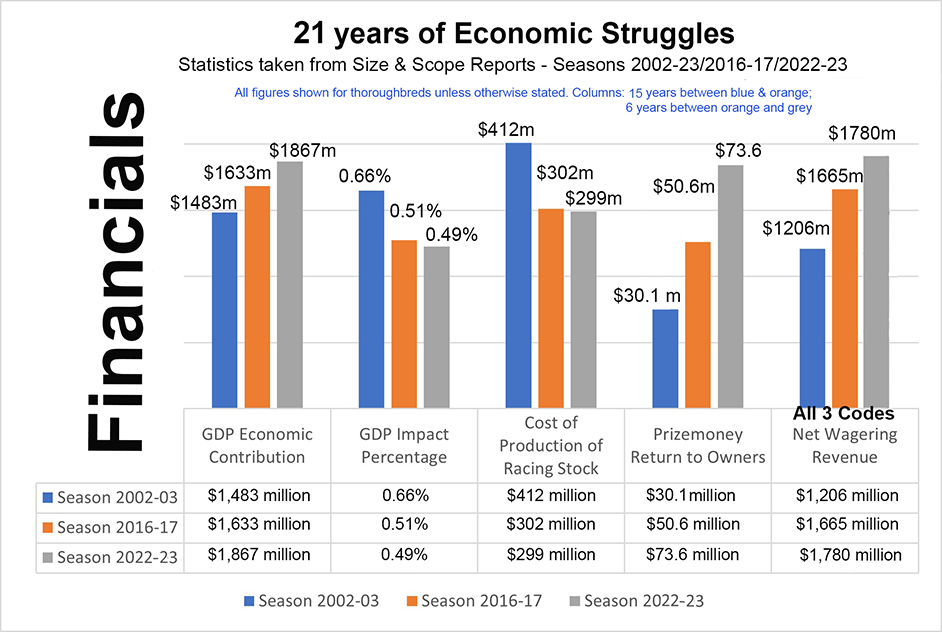
Inflation needs to be considered when looking at the dollars. If you use the rule of thumb that the cost of everything doubles every 10 years, then the 2002-03 figure of $30,1 million looks healthy compared to the John Allen/Glenda Hughes era of 2016-17 when NZRB infamously borrowed money to increase the stakes to a paltry $50.6 million to race for a minimum of $10,000.
Winston got the Free Tax through parliament in 2005, bringing the industry $33 million in the first year, and every year recurring, increasing annually with inflation.
But the opportunists in the Governments of those days saw an opening to withhold most of these funds from the horse industry and build an NZRB Gravy Train to benefit the non-racing set, including politicians who moved sideways.
Between 2005 and 2017, NZRB salaries and wages rose from $27 million to $66 million (+244%), while the apathetic horse industry suffered in silence – a ‘rort’ that made the Fine Cotton ring-in look like stealing candy from a kid.
No one went to jail or even got charged, but they should have.
The $73.6 million stakes figure for the 2022-23 season no longer applies, eclipsed by Entain’s injection of funds for stakes, which has more than thrown racing a lifeline, but it’s fair to say the increased stakes are having little effect on the breeding industry.
Entain arrived in June of 2023, a few months before the 2023 breeding season, in which 396 fewer mares went to a stallion.
Finally, here’s my personnel graph:
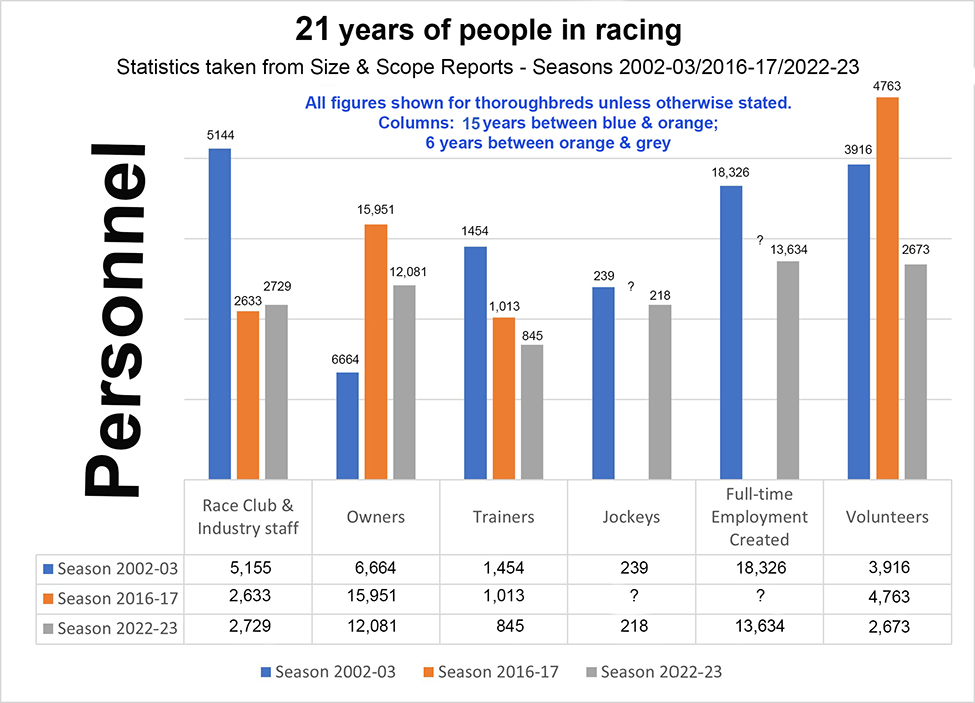
In line with breeding and racing, the Size & Scope numbers of people have diminished accordingly. Trainers have done it tough for years, many only breaking even on training fees, relying on selling a horse they own or part-own, and stakes-winning percentages.
Predictably, the stats say trainers have declined in numbers by 42 percent in 21 years, slightly more than the 21-year decline in horse numbers (36%).
Owners have increased through syndication as horse racing costs became prohibitive for many individual owners. But even with a small percentage of ownership, the owner numbers have declined in the past six years, which is a baffling stat, considering a seeming proliferation of micro-ownership.
In conclusion:
The numbers quoted here in these graphs come from industry reports available on the TAB and NZTR websites. The reporting standard has declined, with the 2022-23 report missing several vital items contained in its 21-year-older predecessor.
All reporting has declined over the 21 years, and the industry today has less transparency as the numbers have worsened. The TAB ceased publishing its website’s monthly wagering reports almost two years ago, and more recently, the stakeholders no longer receive weekly dashboards for wagering.
The helicopter view of 21 years paints a bleak picture of where the thoroughbred business is trending. No one in racing will enjoy reading it, but the industry needs to face up to it and act accordingly: NZTR, NZTBA, NZROA and all other thoroughbred-related bodies need to stop strolling and break into a gallop.
NZTR is on the verge of appointing a new CEO replacement for the recently departed Bruce Sharrock. In a difficult-to-fathom move, they initially hired an Australian recruitment agency to fine down the 90 applicants to a short-list, but to the board’s credit, they had a rethink about the appointment process and have gone down a different track.
The wait for an appointment will be worth it if the best candidate can be found – surely someone in those 90 will be an asset. The board will be fully aware that racing cannot afford a repeat of several failures made by past boards.

